Intel's Pentium M Desktop Part II: ASUS' Pentium M to Pentium 4 Socket Adapter
by Anand Lal Shimpi on March 24, 2005 1:31 PM EST- Posted in
- CPUs
Business/General Use Performance
Business Winstone 2004
Business Winstone 2004 tests the following applications in various usage scenarios:- Microsoft Access 2002
- Microsoft Excel 2002
- Microsoft FrontPage 2002
- Microsoft Outlook 2002
- Microsoft PowerPoint 2002
- Microsoft Project 2002
- Microsoft Word 2002
- Norton AntiVirus Professional Edition 2003
- WinZip 8.1
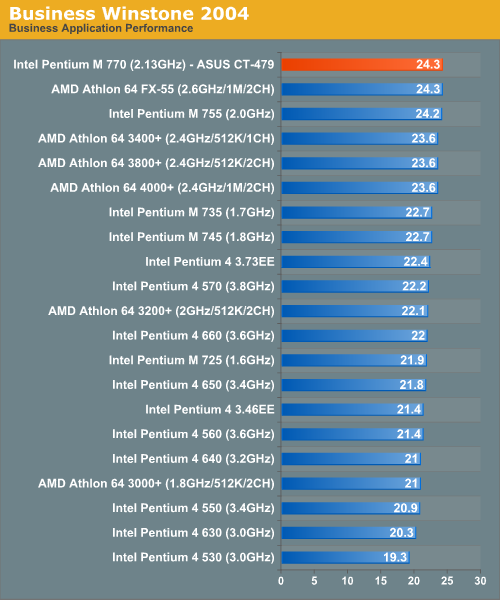
Office Productivity SYSMark 2004
SYSMark's Office Productivity suite consists of three tests, the first of which is the Communication test. The Communication test consists of the following:"The user receives an email in Outlook 2002 that contains a collection of documents in a zip file. The user reviews his email and updates his calendar while VirusScan 7.0 scans the system. The corporate web site is viewed in Internet Explorer 6.0. Finally, Internet Explorer is used to look at samples of the web pages and documents created during the scenario."
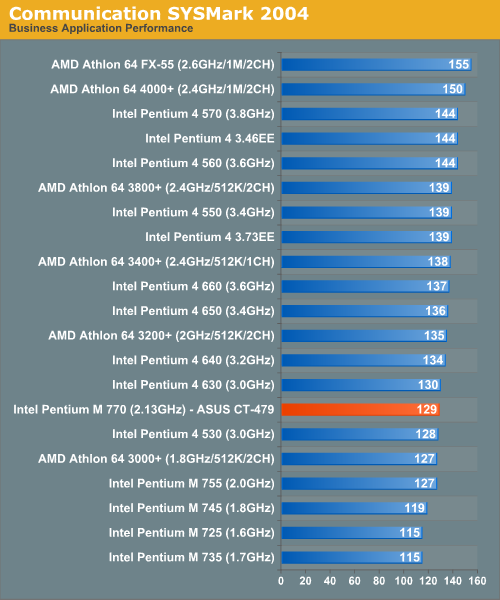
The next test is Document Creation performance:
"The user edits the document using Word 2002. He transcribes an audio file into a document using Dragon NaturallySpeaking 6. Once the document has all the necessary pieces in place, the user changes it into a portable format for easy and secure distribution using Acrobat 5.0.5. The user creates a marketing presentation in PowerPoint 2002 and adds elements to a slide show template."
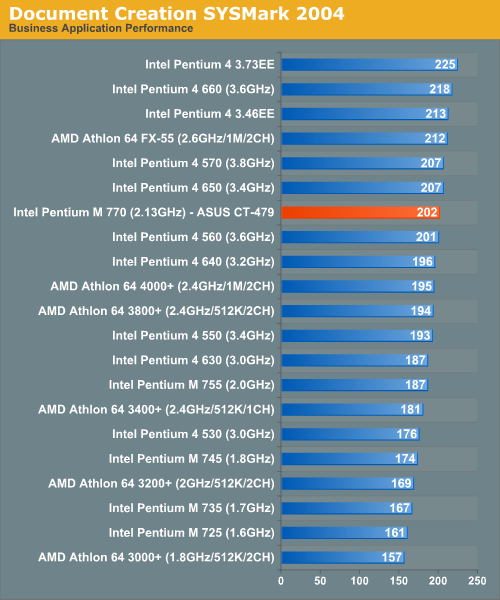
The final test in our Office Productivity suite is Data Analysis, which BAPCo describes as:
"The user opens a database using Access 2002 and runs some queries. A collection of documents are archived using WinZip 8.1. The queries' results are imported into a spreadsheet using Excel 2002 and are used to generate graphical charts."
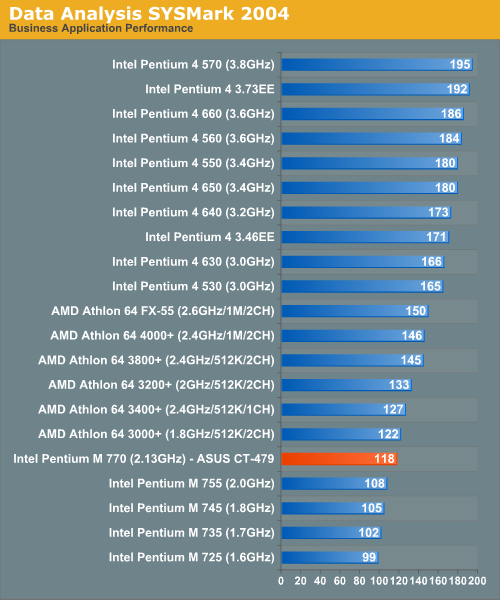
Mozilla 1.4
Quite possibly the most frequently used application on any desktop is the one that we pay the least amount of attention when it comes to performance. While a bit older than the core that is now used in Firefox, performance in Mozilla is worth looking at as many users are switching from IE to a much more capable browser on the PC - Firefox.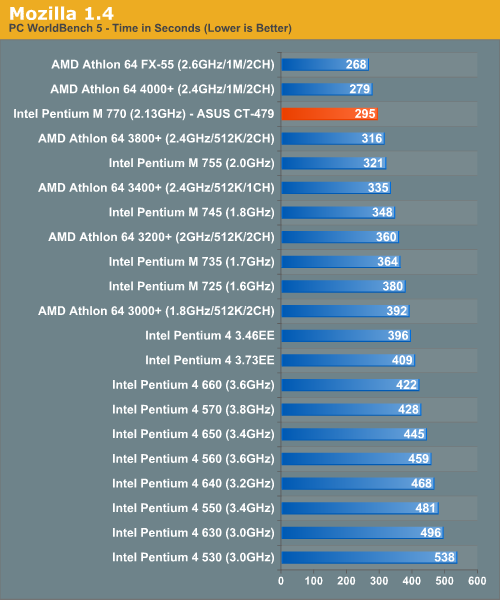
ACD Systems ACDSee PowerPack 5.0
ACDSee is a popular image editing tool that is great for basic image editing options such as batch resizing, rotating, cropping and other such features that are too elementary to justify purchasing something as powerful as Photoshop. There are no extremely complex filters here, just pure batch image processing.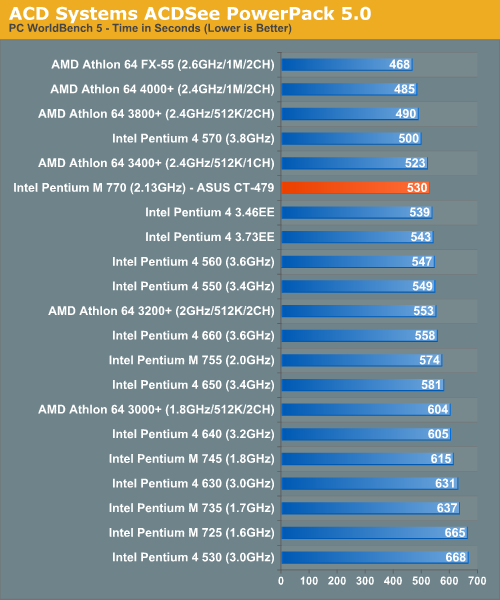
Winzip
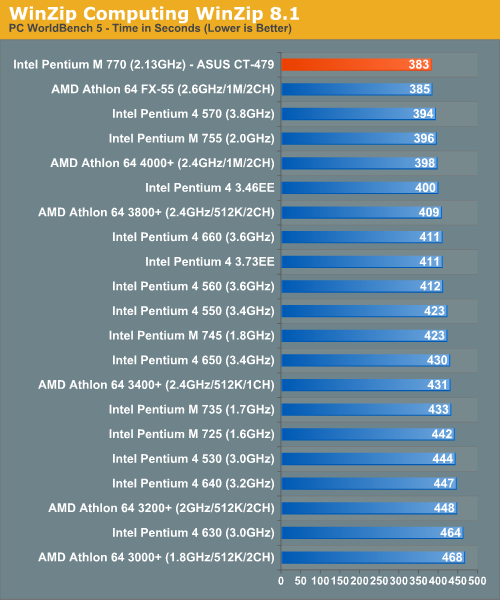
Let's look at how its peak theoretical performance is under WinRAR's built in benchmark:
WinRAR 3.40
Pulling the hard disk out of the equation, we can get a much better idea of which processors are truly best suited for file compression.










48 Comments
View All Comments
Houdani - Thursday, March 24, 2005 - link
With updates to floating point calculations and adding another core, Intel will need to think long and hard about putting their desktop chips into premature end-of-life in favor of going forward with the PM as their base product.Or, to summarize:
Blah blah blah nothing new that hasn't already been said before blah blah blather.
mlittl3 - Thursday, March 24, 2005 - link
Anand,You completely missed the point of the excellent data you obtained. Of course, this is just my point of view but here is my take on things.
The Pentium III stopped at 1.4 GHz. The Pentium picked up at 1.5 GHz (not including the low and ultra low voltage versions). We all know that the Pentium M is much more similar to the Pentium III than the Pentium IV. What if Intel never created the Pentium IV and continued improvements with the Pentium III? We would have had the Pentium M three to four years ago.
Intel screwed us all with its monopoly powers and sold high clock speeds to the masses with no thought about the performance of the Pentium IV. The last four years have shown us just that but no one complains or holds Intel accountable. As you have pointed out numerous times, the capital processor of the Pentium IV series, the Pentium IV EE is a complete waste of money.
In almost all of your benchmarks, the Pentium M shows almost the EXACT same performance as an Athlon 64 clock for clock. I say again, what if the Pentium M was developed at the time the Pentium III was discontinued? Intel and AMD would have matched clock speeds and we would have a Pentium M around 2.6 GHz right now with the similar performance of the Athlon 64 FX-55. The improvements you mentioned in the conclusion for Yonah (SSE and floating point) would probably already be implemented.
The Pentium M is THE processor from Intel. We had to wait four years for Intel's monopoly to be weakened but now we have a processor worth something. With multiple cores (each running at the speed of single cores since the Pentium M runs so cool) and all the other improvements from Yonah, that processor is going to be awesome.
Thank god for AMD challenging Intel with their terrific Athlon 64 architecture. Without them, computer processing would be in the dark ages. Guys, we need to stop supporting companies when they get to a certain size. The market needs to shift or we are going to get software like Windows and processors like the Pentium IV. With an even market share split between at least two companies, technology will excel past our wildest imaginations.
Okay, I will shut up now. I do want to add one thing. The ASUS adapter does nothing over the Aopen motherboard. If I am not mistaken, you compared a 533 MHz FSB, 133 MHz faster Dothan Pentium M to 400 MHz FSB, slower Dothans (I hope the other processors were Dothans and not Banias). The performance delta between the 770 and the 750 is exactly what you would expect from a faster clocked processor and a faster FSB. The 865 vs. the 855GME had nothing to do with the performance difference. The only advantage of the ASUS adapter is a cheaper overall cost of ownership.
bob661 - Thursday, March 24, 2005 - link
Oh yeah, if you're going Intel, this is the only CPU to own.bob661 - Thursday, March 24, 2005 - link
Intel really needs to lower the price of this CPU. A 765 is $645 on newegg. I can only imagine what the 770 would cost. If it was more price competitve, the P-M would be an excellent processor choice.rqle - Thursday, March 24, 2005 - link
i thought it did pretty well clock for clock on majority of the benchmark against the amd64 and did on par or so on gaming against the amd FX chips. Where it exceeds the PM it deal extremely well, and falls really shorts on things it didnt fair to well.Price wise for a "Desktop", i still believe AMD64 chip is the way to go. Great notebook chip that is not quite ready for the desktop area yet, need to improve its floating point performance and some desktop area. Did pretty well as gaming chip.
clarkey01 - Thursday, March 24, 2005 - link
Multitasking..lol...I mean, your going to get Intel fanboys saying " Its only has a 400 MHZ FSB" and what not. Well, why has it > ? its like saying the FX only has one meg cache, why doesnt it have two ?
clarkey01 - Thursday, March 24, 2005 - link
Mixed bag or what.Aileur - Thursday, March 24, 2005 - link
All in all seems like a middle of the pack solution. I thought the dual channel would give it a more significant boost but the pentium m seems to stay in the middle of the pack most of the time.I would still get it before i ever touched a prescott with a ten foot pole (and im an ex northwood user) but for the price theyre asking for dothans I dont see it being the desktop chip killer i was expecting.
I wonder though how Intel could clock this thing if it didnt have low power/heat in mind.